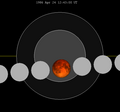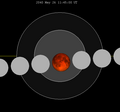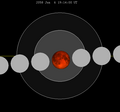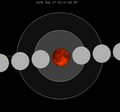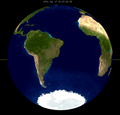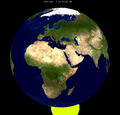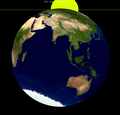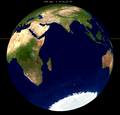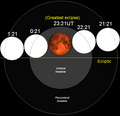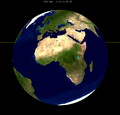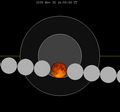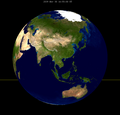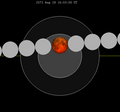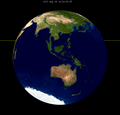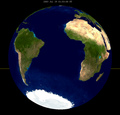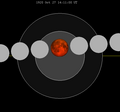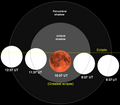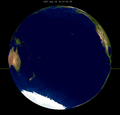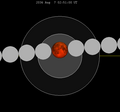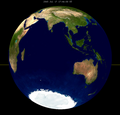Top Qs
Timeline
Chat
Perspective
June 2094 lunar eclipse
Central lunar eclipse From Wikipedia, the free encyclopedia
Remove ads
A total lunar eclipse will occur at the Moon’s descending node of orbit on Monday, June 28, 2094,[1] with an umbral magnitude of 1.8249. It will be a central lunar eclipse, in which part of the Moon will pass through the center of the Earth's shadow. A lunar eclipse occurs when the Moon moves into the Earth's shadow, causing the Moon to be darkened. A total lunar eclipse occurs when the Moon's near side entirely passes into the Earth's umbral shadow. Unlike a solar eclipse, which can only be viewed from a relatively small area of the world, a lunar eclipse may be viewed from anywhere on the night side of Earth. A total lunar eclipse can last up to nearly two hours, while a total solar eclipse lasts only a few minutes at any given place, because the Moon's shadow is smaller. Occurring about 1.9 days before perigee (on June 30, 2094, at 7:50 UTC), the Moon's apparent diameter will be larger.[2]
While the visual effect of a total eclipse is variable, the Moon may be stained a deep orange or red color at maximum eclipse. With a gamma value of only 0.0288 and an umbral eclipse magnitude of 1.8249, this is the greatest eclipse in Lunar Saros 131 as well as the second largest and darkest lunar eclipse of the 21st century.
During the eclipse, NGC 6629 will be occulted by the Moon over Northeast Australia and the Pacific Ocean; NGC 6642 will be occulted by the Moon over New Guinea, Northern Australia and the Pacific Ocean. Deep-sky objects are rarely occulted during a total eclipse from any given spot on Earth.[3]: 161
Remove ads
Visibility
The eclipse will be completely visible over eastern Australia, Antarctica, and the central and eastern Pacific Ocean, seen rising over east Asia and western Australia and setting over North and South America.[4]
  |
Eclipse details
Shown below is a table displaying details about this particular lunar eclipse. It describes various parameters pertaining to this eclipse.[5]
Remove ads
Eclipse season
This eclipse is part of an eclipse season, a period, roughly every six months, when eclipses occur. Only two (or occasionally three) eclipse seasons occur each year, and each season lasts about 35 days and repeats just short of six months (173 days) later; thus two full eclipse seasons always occur each year. Either two or three eclipses happen each eclipse season. In the sequence below, each eclipse is separated by a fortnight. The first and last eclipse in this sequence is separated by one synodic month.
Related eclipses
Summarize
Perspective
Eclipses in 2094
- A partial lunar eclipse on January 1.
- A total solar eclipse on January 16.
- A partial solar eclipse on June 13.
- A total lunar eclipse on June 28.
- A partial solar eclipse on July 12.
- A partial solar eclipse on December 7.
- A total lunar eclipse on December 21.
Metonic
- Preceded by: Lunar eclipse of September 8, 2090
- Followed by: Lunar eclipse of April 15, 2098
Tzolkinex
- Preceded by: Lunar eclipse of May 17, 2087
- Followed by: Lunar eclipse of August 9, 2101
Half-Saros
- Preceded by: Solar eclipse of June 22, 2085
- Followed by: Solar eclipse of July 4, 2103
Tritos
- Preceded by: Lunar eclipse of July 29, 2083
- Followed by: Lunar eclipse of May 28, 2105
Lunar Saros 131
- Preceded by: Lunar eclipse of June 17, 2076
- Followed by: Lunar eclipse of July 9, 2112
Inex
- Preceded by: Lunar eclipse of July 17, 2065
- Followed by: Lunar eclipse of June 9, 2123
Triad
- Preceded by: Lunar eclipse of August 28, 2007
- Followed by: Lunar eclipse of April 29, 2181
Lunar eclipses of 2092–2096
This eclipse is a member of a semester series. An eclipse in a semester series of lunar eclipses repeats approximately every 177 days and 4 hours (a semester) at alternating nodes of the Moon's orbit.[6]
The penumbral lunar eclipses on February 23, 2092 and August 17, 2092 occur in the previous lunar year eclipse set, and the penumbral lunar eclipses on May 7, 2096 and October 31, 2096 occur in the next lunar year eclipse set.
Saros 131
This eclipse is a part of Saros series 131, repeating every 18 years, 11 days, and containing 72 events. The series started with a penumbral lunar eclipse on May 10, 1427. It contains partial eclipses from July 25, 1553 through March 22, 1932; total eclipses from April 2, 1950 through September 3, 2202; and a second set of partial eclipses from September 13, 2220 through April 9, 2563. The series ends at member 72 as a penumbral eclipse on July 7, 2707.
The longest duration of totality will be produced by member 38 at 100 minutes, 36 seconds on June 28, 2094. All eclipses in this series occur at the Moon’s descending node of orbit.[7]
Eclipses are tabulated in three columns; every third eclipse in the same column is one exeligmos apart, so they all cast shadows over approximately the same parts of the Earth.
Tritos series
This eclipse is a part of a tritos cycle, repeating at alternating nodes every 135 synodic months (≈ 3986.63 days, or 11 years minus 1 month). Their appearance and longitude are irregular due to a lack of synchronization with the anomalistic month (period of perigee), but groupings of 3 tritos cycles (≈ 33 years minus 3 months) come close (≈ 434.044 anomalistic months), so eclipses are similar in these groupings.
Inex series
This eclipse is a part of the long period inex cycle, repeating at alternating nodes, every 358 synodic months (≈ 10,571.95 days, or 29 years minus 20 days). Their appearance and longitude are irregular due to a lack of synchronization with the anomalistic month (period of perigee). However, groupings of 3 inex cycles (≈ 87 years minus 2 months) comes close (≈ 1,151.02 anomalistic months), so eclipses are similar in these groupings.
Half-Saros cycle
A lunar eclipse will be preceded and followed by solar eclipses by 9 years and 5.5 days (a half saros).[9] This lunar eclipse is related to two annular solar eclipses of Solar Saros 138.
Remove ads
See also
Notes
External links
Wikiwand - on
Seamless Wikipedia browsing. On steroids.
Remove ads















